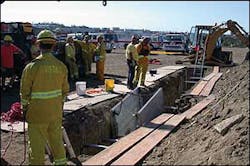One of your engine companies receives an EMS response for an unconscious person. Upon arrival, the firefighters are confronted with a male patient almost completely buried in a construction trench with only part of his face visible. The trench is approximately 10 feet deep, four feet wide and 40 feet long. The officer orders the placement of a portable ladder into the trench and two firefighters make their way to the patient to assess his condition. Just as the firefighters reach the patient, a large section of the sidewall of the trench collapses, nearly trapping one of the firefighters. The officer orders the members out of the trench and requests the dispatcher to assign a technical-rescue response to the incident.
Has this happened in your jurisdiction? Firefighters all around the country respond to technical rescue situations every day. Whether it’s a trench collapse, confined-space incident or high-angle rope job, we get the call. Many times, the initial response is just as described above: a single-unit medical response. Do you train your first-line units in technical-rescue awareness? What are your department’s capabilities to respond to these types of incidents? Do you rely on mutual aid units or regional response teams? What is your plan? How will you address the situation at hand?
Statistically, more than half of the fatalities at technical-rescue incidents are those of the would-be rescuers. Some are well-intentioned co-workers or family members. Many are first-responding firefighters. Fire departments across the country are challenged to provide basic fire training to line units. Technical-rescue awareness training is above and beyond the normal fire training we are required to do.
Firefighters and their supervisors must realize we are all in the hazardous response business. As first responders, we will inevitably be faced with a “specialized” incident. This obligates us to provide our first-line troops with not only a basic awareness of the hazards present at technical-rescue incidents, but the tools required to address the impeding issues. Your members must be trained in the procedures necessary to also operate in a support role, gathering information and preparing the scene prior to the arrival of a trained technical-rescue response team. Whether your department has a dedicated technical rescue team or you rely on mutual aid, you should consider training with these teams to become comfortable with their tactics and equipment in order to effectively operate in a support role. Make sure your members are familiar with the various Occupational Safety and Health Administration (OSHA) standards that exist regarding the different technical-rescue operations. The chief of your department needs to delineate what your role will be at a technical-rescue incident and train the members to operate at that level. Be ready to initiate a technical-rescue response in your community. Also, realize many jurisdictions have a tiered response that depends on the severity of the situation and the number of casualties.
With all of the above being said, the key decision that needs to be made at all specialized operations is that of rescue versus recovery. At the incident described here, it was determined that the patient had been buried for over an hour. The actions taken could have been disastrous for the fire department. Drill, train and familiarize yourself with specialized operations. Your life will depend on it!
Richard J. Blatus is a 23-year veteran of the fire service, currently assigned to Battalion 15 in Bronx, NY. A strong proponent of training, Chief Blatus has served as both a regional and national instructor/lecturer for fire service trade publications and conferences, such as Firehouse Expo. He holds degrees in business and municipal fire administration.Thomas J. Richardson is a 23-year veteran of the fire service, currently serving the FDNY at Battalion 38 in Brooklyn. A former chief of the Deer Park, NY, Volunteer Fire Department, Chief Richardson is an adjunct instructor for the Suffolk County, NY, Fire Training Academy.






